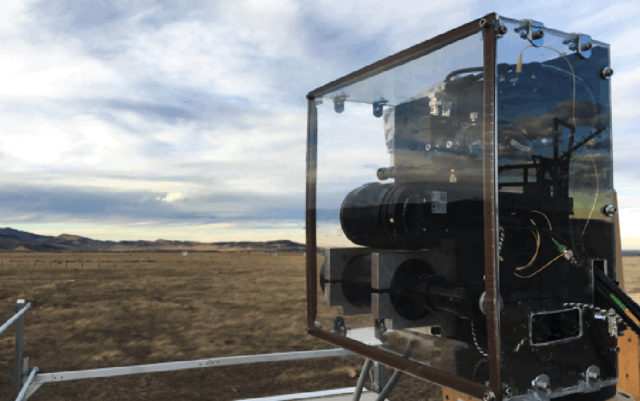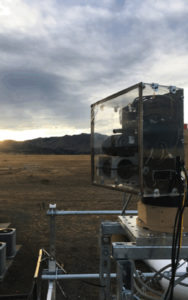
When it comes to the oil and gas industry, business practices and environmental sustainability are often at odds with each other.
But a team of engineers and researchers from University of Colorado Boulder’s Cooperative Institute for Research in Environmental Sciences (CIRES), the National Oceanic and Atmospheric Administration (NOAA) and the National Institute of Standards and Technology (NIST) have developed a technology that seeks to bridge the divide with a futuristic beam of color-sensitive, gas-tracking light.
Devised in Boulder, this new creation combs the air with laser teeth to detect greenhouse gasses. Its beams are so sensitive, they can recognize even trace amounts of methane, carbon dioxide and water from miles away. It’s a massive improvement to current monitoring technologies.
“There are two techniques in use right now,” explains Greg Rieker, a professor of mechanical engineering at CU, and the principal investigator of the project. “One of them is to do nothing. … The other one is called an optical gas imaging camera.”
The infamous Aliso Canyon methane leak in Porter Ranch, California, was recorded from a helicopter using one of these cameras. The haunting black and white footage revealed a dark column of methane gas climbing into the air and dissipating over the Earth — a column that was otherwise invisible to the naked eye.
However, optical gas imaging cameras do not usually show methane leaks so clearly, says Rieker. “That technology, it’s not very sensitive. But the Aliso Canyon leak was so massive that you could see it from a helicopter. That’s pretty atypical.”
The Aliso Canyon catastrophe expelled 5.3 gigatons of methane into the atmosphere. Thousands of families were evacuated from their homes due to severe health concerns. And SoCalGas was slapped with over 1,000 lawsuits and a $4-million fine — a costly ordeal for all parties involved.
Considering that Colorado is a national hotspot for natural resource extraction, accidents like Aliso Canyon raise some legitimate concerns for communities throughout this state.
Sean Coburn, a CU research associate in Rieker’s lab working on the deployment and technical side of the laser system, says this region is full of resource extraction sites.
“In the Denver-Julesburg basin alone I think there’s somewhere on the order of 40,000 different oil or gas wells,” he says. “It’s one of the more densely populated regions of production wells in the United States.”
Which is partly what inspired this diverse team of researchers to find a better method for preventing leaks. With so much oil and gas production going on in Boulder County’s backyard, it seemed pertinent to find a way to reduce the risk factor.
Enter the dual-frequency comb laser spectrometer.

The laser itself, which was developed at CU, won its creator, John Hall, the 2005 Nobel Prize in Physics. Each laser beam measures different frequencies (or, colors) of light as they pass through different gasses in the air.
“This laser is different than most lasers in that it emits hundreds of thousands of wave-lengths at once,” says Rieker. Those hundreds of thousands of wavelength-detecting beams make up the “teeth” of the comb.
Because different greenhouse gasses absorb light differently, each “tooth” can measure the spectral signature of whatever it passes through. If they pass through methane, the frequency of light changes within the laser beams, which bounce back to their source off of strategically placed retroreflectors and report what they’ve discovered to their optical head.
“What that lets us do is see a fingerprint — a unique absorption fingerprint of each of the different molecules,” Rieker describes. “And then we can tell exactly how much methane, water or CO2 is in the beam path.”
By firing these laser combs outwards in a star-like pattern, huge swaths of land can be continually monitored with extreme sensitivity and accuracy, all at once. And by keeping close watch of wind patterns and temperature changes, if a leak is detected, it can be traced directly back to its source to be fixed before it becomes more of a hazard.
This represents a huge step toward better monitoring of resource extraction practices. And the developers are keenly aware of the business potential for their new technology.
“We’ve spun out a startup from the University here, called LongPath Technologies,” says Caroline Alden, a research scientist at CIRES who worked closely with Rieker’s lab on this project. Although the startup is brand new, they’ve already found some potential industry partners in Colorado and elsewhere in North America,” she says. “We’re hoping to ramp up and offer monitoring services or some sort of solution for oil and gas companies looking for natural gas leaks.”
And the sooner, the better. People and communities near oil and gas wells will be safer for it, the environment will be better protected because of it and oil and gas businesses will experience less profit loss once LongPath Technologies takes off.














